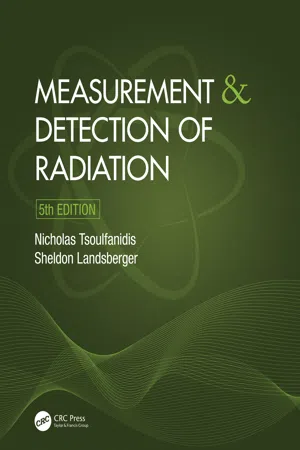
- 660 pages
- English
- ePUB (mobile friendly)
- Available on iOS & Android
Measurement and Detection of Radiation
About this book
As useful to students and nuclear professionals as its popular predecessors, this fifth edition provides the most up-to-date and accessible introduction to radiation detector materials, systems, and applications. There have been many advances in the field of radiation detection, most notably in practical applications. Incorporating these important developments, Measurement and Detection of Radiation, Fifth Edition provides the most up-to-date and accessible introduction to radiation detector materials, systems, and applications. It also includes more problems and updated references and bibliographies, and step-by-step derivations and numerous examples illustrate key concepts.
New to the Fifth Edition:
• Expanded chapters on semiconductor detectors, data analysis methods, health physics fundamentals, and nuclear forensics.
• Updated references and bibliographies.
• New and expanded problems.
Frequently asked questions
- Essential is ideal for learners and professionals who enjoy exploring a wide range of subjects. Access the Essential Library with 800,000+ trusted titles and best-sellers across business, personal growth, and the humanities. Includes unlimited reading time and Standard Read Aloud voice.
- Complete: Perfect for advanced learners and researchers needing full, unrestricted access. Unlock 1.4M+ books across hundreds of subjects, including academic and specialized titles. The Complete Plan also includes advanced features like Premium Read Aloud and Research Assistant.
Please note we cannot support devices running on iOS 13 and Android 7 or earlier. Learn more about using the app.
Information
1
Introduction to Radiation Measurements
1.1 WHAT IS MEANT BY RADIATION?
| Particle | Energy (MeV) |
|---|---|
| α | 20 |
| β | 10 |
| γ | 20 |
| n | 20 |
| Heavy ions | 100 |
1.2 STATISTICAL NATURE OF RADIATION EMISSION
1.3 UNCERTAINTY*, ACCURACY AND PRECISION OF MEASUREMENTS
- Axiom 1: No measurement yields a result without an uncertainty.
- Axiom 2: The result of a measurement is almost worthless unless the uncertainty with that result is also reported.
- (Measured or computed value of quantity Q) − (True value of Q)
- Estimated uncertainty of the measured or computed value of Q.
Table of contents
- Cover
- Half Title
- Title Page
- Copyright Page
- Dedication Page
- Contents
- Preface to the First Edition
- Preface to the Second Edition
- Preface to the Third Edition
- Preface to the Fourth Edition
- Preface to the Fifth Edition
- Authors
- Chapter 1. Introduction to Radiation Measurements
- Chapter 2. Uncertainties of Radiation Counting
- Chapter 3. Review of Atomic and Nuclear Physics
- Chapter 4. Energy Loss and Penetration of Radiation through Matter
- Chapter 5. Gas-Filled Detectors
- Chapter 6. Scintillation Detectors
- Chapter 7. Semiconductor Detectors
- Chapter 8. Relative and Absolute Measurements
- Chapter 9. Introduction to Spectroscopy
- Chapter 10. Electronics for Radiation Counting
- Chapter 11. Data Analysis Methods
- Chapter 12. Photon (γ-Ray and χ-Ray) Spectroscopy
- Chapter 13. Charged-Particle Spectroscopy
- Chapter 14. Neutron Detection and Spectroscopy
- Chapter 15. Activation Analysis and Related Techniques
- Chapter 16. Health Physics Fundamentals
- Chapter 17. Nuclear Forensics
- Chapter 18. Nuclear Medicine Instrumentation
- Appendix A: Useful Constants and Conversion Factors
- Appendix B: Atomic Masses and Other Properties of Isotopes
- Appendix C: Alpha, Beta, and Gamma Sources Commonly Used
- Appendix D: Tables of Photon Attenuation Coefficients
- Appendix E: Table of Buildup Factor Constants
- Appendix F: Table Gamma-Ray Attenuation Coefficients and Buildup Factors for Engineering Materials from the American National Standard ANSI/ANS-6.4.3–1991
- Index